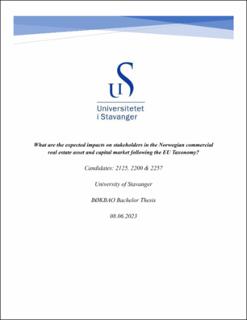| dc.contributor.advisor | Kipperberg, Gorm. | |
| dc.contributor.author | Aartun, Stian | |
| dc.contributor.author | Dirdal, Håkon | |
| dc.contributor.author | Rosnes, Rune Høyvik | |
| dc.date.accessioned | 2023-07-26T15:51:38Z | |
| dc.date.available | 2023-07-26T15:51:38Z | |
| dc.date.issued | 2023 | |
| dc.identifier | no.uis:inspera:145995936:70265575 | |
| dc.identifier.uri | https://hdl.handle.net/11250/3081479 | |
| dc.description.abstract | By studying the impact of current and future environmental requirements set forth by the European Union and concretized by means of the EU Taxonomy, this report has found important milestones in 2027, 2030 and 2050 where financial regulations for the commercial real estate industry will come into effect in the EU.
Combining document analysis and interviewing in-depth 12 different stakeholders in the industry, the study has seeked to get an understanding of the preparedness and willingness to change into more sustainable activities among the Norwegian market participants, as well as what the actual consequences will be.
The results are heavily dependent on the Norwegian government, playing a pivotal role in setting the stage for the many players operating inside and outside of the national borders, and by deciding how to interact with EU rules and regulations through the EEA agreement. For the market participants where “you become green when it pays off to become green”, it appears as big stick diplomacy will be required by politicians, leveraging the power of regulations and potentially shaking up entire financial ecosystems in the quest to combat climate change.
Complying fully and promptly with the EU directives and only providing loans to truly green assets, will enable a swift transition to a sustainable society, benefitting from the truly impressive €1 trillion pool of funding committed by the European Commission.
Contrary to initial assumptions on how differentiated interest levels would greatly benefit green buildings, the actual differences have currently proven to be insignificant with between 0,1 to 0,25% better rates. The real impact is being eligible for bank or bond loan at all, risking commercial real estates becoming de facto stranded assets. | |
| dc.description.abstract | By studying the impact of current and future environmental requirements set forth by the European Union and concretized by means of the EU Taxonomy, this report has found important milestones in 2027, 2030 and 2050 where financial regulations for the commercial real estate industry will come into effect in the EU.
Combining document analysis and interviewing in-depth 12 different stakeholders in the industry, the study has seeked to get an understanding of the preparedness and willingness to change into more sustainable activities among the Norwegian market participants, as well as what the actual consequences will be.
The results are heavily dependent on the Norwegian government, playing a pivotal role in setting the stage for the many players operating inside and outside of the national borders, and by deciding how to interact with EU rules and regulations through the EEA agreement. For the market participants where “you become green when it pays off to become green”, it appears as big stick diplomacy will be required by politicians, leveraging the power of regulations and potentially shaking up entire financial ecosystems in the quest to combat climate change.
Complying fully and promptly with the EU directives and only providing loans to truly green assets, will enable a swift transition to a sustainable society, benefitting from the truly impressive €1 trillion pool of funding committed by the European Commission.
Contrary to initial assumptions on how differentiated interest levels would greatly benefit green buildings, the actual differences have currently proven to be insignificant with between 0,1 to 0,25% better rates. The real impact is being eligible for bank or bond loan at all, risking commercial real estates becoming de facto stranded assets. | |
| dc.language | eng | |
| dc.publisher | uis | |
| dc.title | What are the expected impacts on stakeholders in the Norwegian commercial real estate asset and capital market following the EU Taxonomy? | |
| dc.type | Bachelor thesis | |
